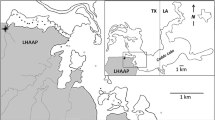Abstract
Toxicity assessments and numerical quality assessment guidelines for estuarine sediments are rarely based on information for aquatic plants. The effect of this lack of information on contaminated sediment toxicity evaluations is largely unknown. For this reason, the toxicities of whole sediments collected from 15 sites in three urbanized Florida bayou-estuaries were determined for the benthic invertebrates Mysidopsis bahia and Ampelisca abdita and the plants Scirpus robustus Pursh (saltmarsh bulrush) and Spartina alterniflora Loisel (saltmarsh cordgrass). The results of the bioassays, conducted for 7 to 28 days, were compared for interspecific differences and to effects-based, sediment quality assessment guidelines. A variety of inorganic and organic analytes were detected in the estuarine sediments, and concentrations of as many as 7 analytes exceeded the sediment guidelines at the 15 sampling locations. Toxicity occurred at 2 of the 15 sampling stations based on invertebrate survival. Twelve of the 15 sediments had either a significant stimulatory or inhibitory effect on early seedling growth relative to a reference sediment (p < 0.05). The phytoresponse was specific to the location, test species, and plant tissue. There was no consistent trend between the sensitivities of the plants and invertebrates exposed to the sediments collected from the same sites. Of the 12 sediments that significantly affected seedling growth, 10 were not acutely toxic to the invertebrates. Consequently, the plant test species provided information that would have been missing if only animal test species were used. For this reason, the phytotoxicity database needs to be expanded for contaminated sediments to further evaluate interspecific sensitivities and to provide perspective on the environmental relevancy of proposed sediment quality criteria and effects-based assessment guidelines for which this information is usually missing. However, additional test method development and field validation are needed to support this effort, which includes the identification of sensitive plant test species, response parameters, and the chemical and physical sediment factors that influence plant growth.
Similar content being viewed by others
Author information
Authors and Affiliations
Additional information
Received: 8 March 2000/Accepted: 22 July 2000
Rights and permissions
About this article
Cite this article
Lewis, M., Weber, D., Stanley, R. et al. The Relevance of Rooted Vascular Plants as Indicators of Estuarine Sediment Quality. Arch. Environ. Contam. Toxicol. 40, 25–34 (2001). https://doi.org/10.1007/s002440010145
Issue Date:
DOI: https://doi.org/10.1007/s002440010145




